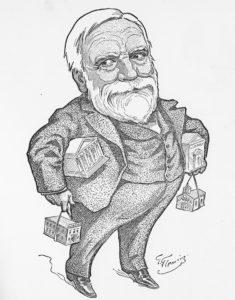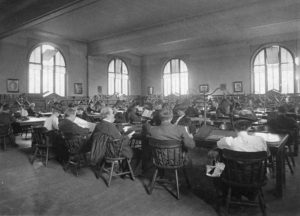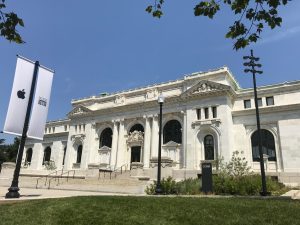A CHANCE ENCOUNTER
DC’s public library system was established by Congress in 1896. The modest public library operated at 1326 New York Avenue NW. As luck would have it, three years later philanthropist and well-known giver of libraries Andrew Carnegie called on President Theodore Roosevelt. As Carnegie waited in a White House anteroom, Brainard Warner, president of library trustees, arrived for his own appointment. Warner seized the moment to ask for a library building for Washington. Carnegie agreed to donate $250,000 towards its construction.

Carnegie required that any city receiving his donation to build a library building had to buy the books and pay for staffing and maintenance. The public library trustees agreed. They held a design competition for a building worthy of the nation’s capital. At this time the City Beautiful movement, based on ornate European models, was the fashion in American municipal architecture.
The winning design called for an elaborately embellished Beaux-Arts structure. By the time the building opened, its cost had exceeded Carnegie’s pledge by $100,000. Fortunately, Carnegie made up the difference.
The Washington Public Library opened in 1903. Even though Carnegie asked that the building not be named for him, Washingtonians have referred to it as the Carnegie Library ever since.
MORE LIBRARIES FOR WASHINGTON, DC
Carnegie funded three branch libraries in DC: Takoma, Mt. Pleasant, and Southeast (Capitol Hill). When Takoma opened in 1911, the library on Mt. Vernon Square was renamed Central Public Library. That name continued officially until 1972, when the library moved to Ninth and G Streets NW and reopened as Martin Luther King Jr. Memorial Library. It remains the system’s centerpiece.
The Carnegie Library opened with a combination of old-fashioned “closed stacks,” from which librarians retrieved books, and new-fangled “open shelves” for public access. Closed stacks were arranged on the north side of the building (their narrow windows are visible reminders today). Large, high-ceilinged reading rooms occupied the west and east sides on two levels. Wide windows and skylights supplied natural light. Each reading room was devoted to a different subject, and there was always a room dedicated to children. In this otherwise segregated city, African Americans and Whites were equally welcomed.

The wildly popular Central Public Library struggled to keep up with the demand. Originally designed with shelf space for 250,000 volumes and room to expand, when it opened, the library already housed 382,352 volumes. Librarians began planning right away for expansion or moving to a larger space with open shelves. Costs, competing city priorities, and world wars delayed the library’s move until 1972.
MODERN DAY MAKEOVER
From 1972 to 1977, the building sat unused. In 1977 the University of the District of Columbia proposed to make it the anchor for a Mt. Vernon Square campus, but later abandoned the plans. In 1999 the District of Columbia granted the Historical Society of Washington, D.C. a 99-year lease on the building to house an urban history museum. The Historical Society raised more than $20 million to renovate the building and opened the City Museum in 2003. Though the museum closed its doors in 2004, the DC History Center has continued to operate its Kiplinger Research Library, exhibits, and programs from the Carnegie Library.

In 2016 Apple executed an agreement with Events DC, which manages the building, to restore the Carnegie Library and lease some space for a store. In 2019 Apple, in partnership with DC History Center and Events DC, completed the restoration, creating today’s architectural gem in downtown DC. Today Apple shares the building with the DC History Center.
The Carnegie Library is listed in the DC Inventory of Historic Sites and in the National Register of Historic Places.
GO DEEPER
To learn more about the history of the Carnegie Library, visit our digital exhibit, A University for the People.